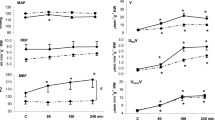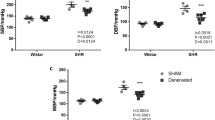Abstract.
Barnidipine is a stereoselective single isomer formulation of a long-term acting dihydropyridine calcium antagonist (CaA). In anaesthetised animals, the antihypertensive response to barnidipine is accompanied by a diuretic effect. The aim of the present study was to examine whether barnidipine increased renal blood flow in a conscious animal model for essential hypertension. We compared the regional specific hemodynamic effects of barnidipine with those obtained with its racemic mixture and amlodipine. Male adult spontaneously hypertensive rats (SHR) were instrumented with Doppler flow probes and catheters to measure renal (RVR), mesenteric (MVR) and hindquarter (HQVR) vascular resistance changes. One week after surgery, barnidipine, its racemic mixture, and amlodipine were intravenously administered at three doses (n≥10 per dose) causing comparable reductions in mean arterial pressure (MAP). At doses of 3, 10 and 30 µg/kg barnidipine reduced MAP (± SEM) by 8±2, 26±3 and 45±4 mmHg. Equipotent effects on MAP were achieved by the racemic mixture of barnidipine at 10, 30 and 100 µg/kg, and by amlodipine at doses of 100, 300 and 1000 µg/kg. Following the 3 µg/kg and 10 µg/kg dose, barnidipine reduced MVR (% ± SEM) by 4±4 and 19±4, and RVR by 8±2 and 15±4, respectively. In contrast, HQVR remained unaltered. Similar data were obtained for the racemic mixture of barnidipine and for amlodipine, although for the latter the changes in RVR were half of those found after barnidipine. After the highest doses of barnidipine, its racemic mixture as well as amlodipine, HQVR fell more than 25% whereas RVR and MVR remained unaltered. Analysis of the dynamic response to the CaAs revealed that the reductions in vascular resistance were associated with decreased myogenic-like oscillations in blood flow.
We conclude that, in conscious SHR, the single isomer barnidipine reduces MAP at doses which are three times lower than its racemic mixture and 30 times lower than amlodipine. In contrast to short-acting CaAs such as nifedipine and isradipine, which reduce mainly HQVR and do not reduce RVR (Nievelstein et al.; Eur J Pharmacol 113:187–198, 1985), the three long-term acting CaAs preferentially dilated the mesenteric and renal vascular bed. In view of the elevation of RVR in essential hypertension, the reduction of RVR may contribute to the long-term antihypertensive effects of barnidipine and amlodipine.
Similar content being viewed by others
Author information
Authors and Affiliations
Additional information
Electronic Publication
Rights and permissions
About this article
Cite this article
Janssen, B.J., Kam, K. & Smits, J.F. Preferential renal and mesenteric vasodilation induced by barnidipine and amlodipine in spontaneously hypertensive rats. Naunyn-Schmied Arch Pharmacol 364, 414–421 (2001). https://doi.org/10.1007/s002100100468
Received:
Accepted:
Issue Date:
DOI: https://doi.org/10.1007/s002100100468




